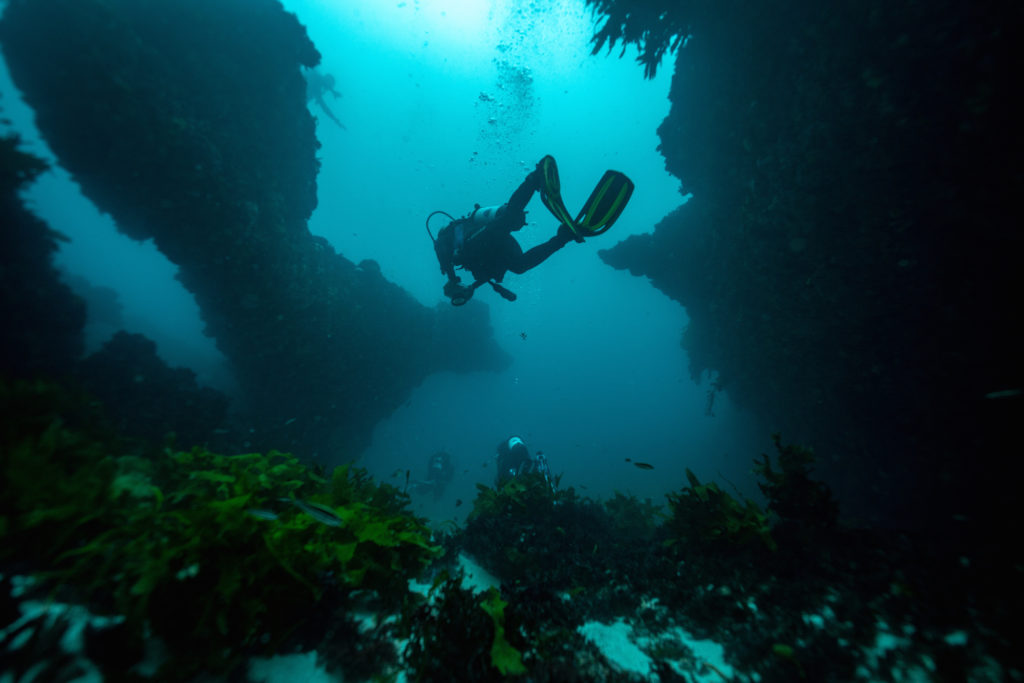Discover Rottnest Island diving.
There’s another side to Western Australia’s favourite island retreat, Rottnest, many of us, haven’t seen – and that is because it’s well-hidden. Deep below its sarongs of beautiful blue waters are a series of underwater caverns that are teeming with vivid marine life – and it’s pretty special.
Rottnest Island is a playground for avid divers and ocean lovers. Its thoroughfares, galleria of corals, caverns, gentle currents, and colourful residents make it an exciting place for a deep-sea safari.
Grab the flippers and mask to meet the island’s other photogenic creatures as we share with you Rottnest Island’s top dive sites.
1. Roe Reef
Northern dive site Roe Reef is a favourite spot for many colourful reasons: bright corals, limestone cliffs, swim-throughs, small currents and is simply full of life. Massive schools of fish (western pomfret) can be found here, as with cuttlefish, catfish, scorpionfish, reddish big scale bullseye, western buffalo bream, and many others spotted in its countless nooks and crannies.
Swimming over its seabed of mustard coloured kelp dancing in unison to the waves is mesmerising and makes you feel even more immersed in another realm.

2. Opera House
Opera House is a grand diving spot, a spectacular concourse of caves galore. The deep dive (30 metres) offers the most impressive light show underwater, with rays of light shining through its caverns, making it a surreal environment to be a part of.
It’s an exciting place to explore, too, with its corals, massive overhangs and the occasional appearance of a grey nurse shark gliding past effortlessly, and giant schools of fish. This site is a pure delight to dive – just make sure you bring the camera to capture it all!
Please note: Opera House is suited to advanced divers only.
3. Tuna Canyon
Located west on the island, Tuna Canyon is about testing your buoyancy as you navigate your way through its deep cavern system. It’s a fun dive, swimming through natural windows from one realm to the next over a galleria of small corals at an average depth of 21 metres.
For those with a keen eye for macro life, lots of fabulous nudibranchs can be spotted here.

4. Shark Cave
Welcome to shark central. Shark Cave – also known as Nurse’s Quarters – is a haven for endangered grey nurse sharks but don’t worry, they aren’t sharp-tooth creatures to be scared about. These harmless sharks make for a fascinating watch as they glide through the waters, oblivious to any underwater crowds. The site is exposed so if weather conditions are optimal, take the opportunity to visit this epic shark hideaway.
Divers here are often greeted by huge smooth Rays and the occasional eagle ray too!
Please note: Shark Cave is suited to advanced divers only.

5. Three Wrecks
Diving in Rottnest Island isn’t just about getting familiar with its sea creatures – it’s also about discovering underwater playgrounds.
Sitting at the north-east side of the island is the dive site, Three Wrecks. As the name suggests, this dive site is home to three shipwrecks dating back to the 1800s. The ships are covered in giant kelp growth, making it a bit of a jungle to explore and hiding some of its visitors like wobbegong shark and crays who are so un-phased by divers they seem to know it is a sanctuary zone.
The site is surrounded by gorgeous scenery and features plenty of swim-throughs with colourful corals and sponges.

The details
Bucket List Diver – Divers can make the most of Rottnest Island’s secret diving spots by going on a half-day diving tour, exploring up to two dive sites in one day.
Based in East Fremantle, Bucket List Diver offers intimate diving experiences with no more than eight divers onboard its vessel.
Want to learn how to dive? Find out more about how you can obtain your PADI open water diving certification here.
Julia travelled as a guest of Bucket List Diver, and all thoughts and opinions are of her own.
Featured image: Paul Pichugin
Related reads: Ningaloo’s World Famous Dive Spot That Requires Flashing Your Passport
See more: Western Australia travel













